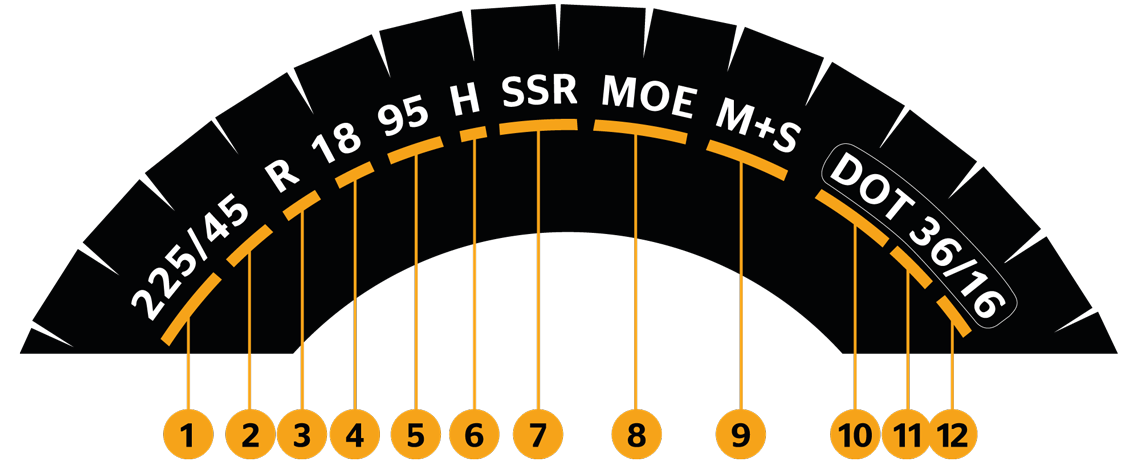
# Tire Basics
Tire markings
Decoding the markings on the tire sidewall

See those markings on the tire sidewall? They are shorthand for a veritable wealth of information. The tire model name is present and correct, obviously, but that’s just the start. There’s also a sequence of numbers detailing the load index, speed rating, tire size, construction, and much more besides.

Why exactly are these markings so important? This information is necessary when the time comes to fit your wheels with replacement tires. Every driver wants to maintain optimal safety and performance when buying new tires; understanding the sidewall markings is an effective way of achieving exactly that.
Follow our tire expert Nels explaining the tire sidewall markings:
Let’s start with the following sequence of tire markings as an example: 225/45 R 18 95 H

Tire width
The first number to appear in the sequence is “225.” This number is the nominal width of the tire (in millimeters) from one sidewall to the other.

Aspect ratio
Following the slash, the next number in the sequence is “45.” This number is the tire’s aspect ratio – essentially the height of the tire’s profile outward from the rim represented as a percentage of the tire’s width. We calculate this number by dividing the tire’s section height by the tire’s section width. So, if a tire has an aspect ratio of 45, that means the tire’s height is 45% of its width.

Construction
Next in our series of tire markings is a letter instead of a number. This letter indicates the type of construction used within the casing of the tire, which in our example is “R” for Radial construction. Other examples are “B” for Bias-ply or “D” for Diagonal construction.
Radial tires are the most common tires on the road today. They’re called radial because the tire’s internal ply cords are orientated in a radial direction, from one bead over to the other, at right angles to the direction of the tire’s rotation.

Rim diameter
The number “18” in our example represents the diameter of the wheel rim in inches.

Load index
The number after the rim diameter represents the load index. In our example, “95” is a code for the maximum load a tire can support when fully inflated. Passenger tires have load indices spanning from 75 to 105, where each numeric value corresponds to a specific load capacity. The carrying capacity for each value is described in a load index chart in your vehicle or tire documentation. More information on the load index.

Speed rating
Last in our sequence, we come to the speed rating. Letters ranging from A to Z represent the speed rating. Each letter denotes the maximum speed a tire can sustain under its recommended load capacity. In our example, “H” is equivalent to a maximum speed of 209 kph (130 mph). Even though a tire is capable of performing at this speed, drivers should not exceed legal speed limits. Read our guide to speed ratings.

Additional markings
After this sequence of information, other letters and symbols may also be present on the sidewall.
In our example, they denote the following:
7 Self-Supporting Run-flat tire
8 Mercedes Original Equipment key
9 Suitable for mud and snow conditions
10 Compliant with US Department of Transportation motor vehicle safety standards
11 Week of manufacture
12 Year of manufacture
Related content
-
 2024/10/17Tire componentsContinental has played a major role in the development of today’s steel-belted radial tires. Learn all about the components inside the modern tire.Read more
2024/10/17Tire componentsContinental has played a major role in the development of today’s steel-belted radial tires. Learn all about the components inside the modern tire.Read more -
 2024/10/17Tire productionA modern tire is made from many components. Follow the tire manufacturing process step by step, from raw materials to finished tires.Read more
2024/10/17Tire productionA modern tire is made from many components. Follow the tire manufacturing process step by step, from raw materials to finished tires.Read more -
 2024/10/17Tire sizeThere are three things to know when buying new tires for your car – the size, speed rating, and load index – and all this information is easy to find.Read more
2024/10/17Tire sizeThere are three things to know when buying new tires for your car – the size, speed rating, and load index – and all this information is easy to find.Read more